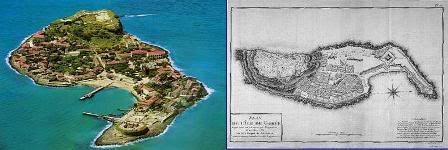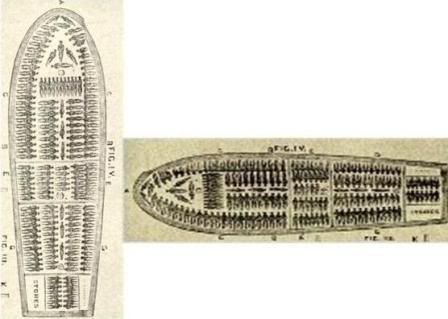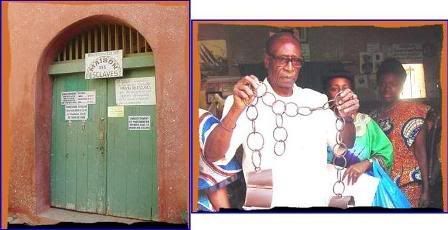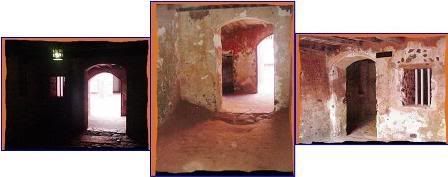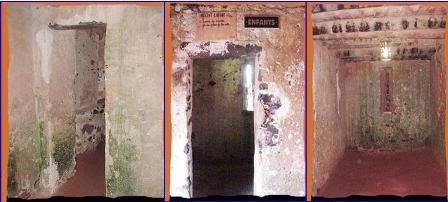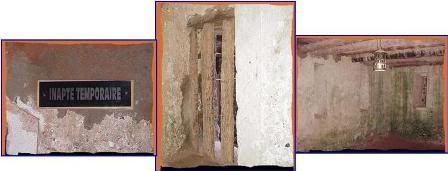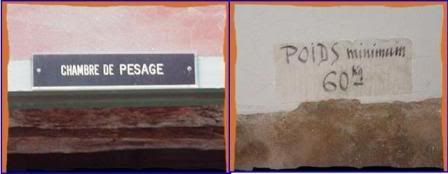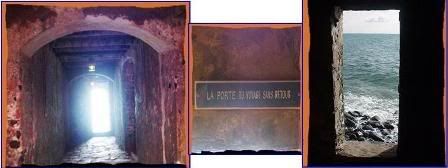Hello :) Here I come with another annoying History lesson for you. I wanted to use Spoiler tags so the laziest readers could skip the text and go right to the pictures, but the new layout still doesn't allow those. So take a look at these categories, place yourself in the one that fits you better and act in consequence ;)
A) Another bloody History lesson? You gotta be kidding me.
*Action to be taken: move it to the next blog.
B) I could check the pics...
*Action to be taken: skip up to the blue text.
C) History rocks my socks!
*Action to be taken: enjoy it!
Virtual visit: http://webworld.unesco.org/goree/en/index.shtml
Gorée is a really small island located 1km south-east from the coast of Dakar, the capital city of the Republic of Senegal. It's hard to find it in the modern maps, although it was recurrent in the old cartography.
Portugal, Holland, UK and France fought over it for centuries. Its name, actually, has Dutch etymology: Good Ree, meaning good harbour. Europeans had huge reasons to fight over its control: Gorée was an excellent natural fort, its shape and orientation allowed the vessels find good protection and it's little beach helped embark and disembark (or rather, load and unload) easy, so the small and quiet fishermen island became and strategic point of a vital importance in the triangular sea commerce between Europe, Africa and America.
From the XV to the XIX century, Gorée became an active spot in the slavery treat. It's estimated that approximately 20 million of Africans stepped on the island as a previous step to their crossing across the Atlantic Ocean.
The "House of the Slaves" was built in 1786, and it was there where the slaves who were just caught were kept until they were sold to the European intermediaries prior to their trip. The weaker ones used to die, and they were simply thrown to the ocean. The stronger ones were fire marked and scarred for life with the shipping company emblem, and then they were loaded and pressed tight together in the decks to be transported to America, where the fast development of the coffee, cotton and sugar crops increased the need of labour and the huge dependence of the slaves, which made the landowners eager to buy big amounts of them.
Even though from the VIII Century African slaves were brought regularly to Asia, the European began the bloodiest stage in the African devastation, in the spread of racial prejudices, in the dehumanization and conversion of the human being into merchandise. However the arrival of the Europeans to America would expand in an unthinkable magnitude the treat of slaves with disastrous consequences. It was the beginning of a chapter in history that would last 4 centuries.
From the very beginning, the "quality of the merchandise" was highly appreciated. Strong, healthy and young slaves were preferred not only because they would be more expensive when sold, but also because of the rigors of the transatlantic crossing, that used to last weeks, and sometimes months.
Slave trader vessels were floating coffins. Almost every day slaves were systematically thrown to the ocean either to avoid contagious diseases to spread to the rest of the "cargo" or to lessen the load (insurance companies wouldn't pay for those slaves who died out of sickness, but they would for those who died drowned while crossing). After the treat was prohibited, they were all thrown altogether to avoid being caught.
This design belongs to the ship Brookes, specially designed to transport slaves. Its maximum capacity was 451 slaves, allowing each of them a 183cm x40 cm room (even less for women and children). However, the Brookes managed to transport 609 slaves. The slave, completely dehumanized, acquired the condition of merchandise for life. Such conditions prompted a tremendous high death rate.
Around the end of the XVI century, the native population of the Caribbean islands had almost disappeared, and their economy depended exclusively on slave labour. Punishment, absolutely regulated by law was part of a slave's daily life. Paradoxically enough, the tyrants used to be black people, bond to perform such bloody task as a means to acquire their own freedom, so they were usually more cruel than white ones.
"The House of the Slaves", used to hold some 150-200 slaves (men, women and children) in atrocious conditions prior to their sale. Entire families were dispersed as they were sold to different and shipped in different vessels. They lost their identity to become an assigned number.
"The House of the Slaves" is nowadays a silent witness of the suffering that those who were caught, piled up and chained in those damp and unhealthy cells were forced to endure for 3 and half centuries. The old shackles still remain attached to the walls. Slaves were forced to wear those day and night, as well as to hold a heavy iron ball in their hands.
These were the men's cells. 30 men were forced to remain seated and chained to the wall by their necks and arms in a 2,60metres x 2,60metres cell, waiting for an uncertain future to the border of insanity. A small window closed with bars was the only ventilation. They were given a meal a day and they were shortly allowed outside once a day to relieve themselves. They were also washed down with salty water to avoid dehydration. Hygiene was deplorable and the first plague in the island sprung here.
These were the women's cells, who lived in exactly the same conditions as men.
These were the cells of the children.
The girls were considered more valuable than their mothers. The bigger their breast, the more valuable the girls were. Virginity was a big plus. Those kids were usually raped, and those who became pregnant were released, so hard as it sounds, little girls were willing to be possessed to obtain their liberty, pregnancy being their only way out of a life full of abuse. Mixed race girls, ironically enough, became the aristocracy of Gorèe.
The mortality rate between the boys was the highest. They were forced to lie down chained in pairs, and they could hardly move. The only fact of crying was severely punished. Most of them used to die out of panic, sadness, fear and loneliness, hence they were the most prized.
These were the cells of the so called non-suitable. The prize of a man was established out of his muscle and weight, which had to remain over 60 kilos. Those who didn't reach it, were give extra food to be able to join the rest and be sold.
This is the weighting cell.
The top floor of the house was inhabited by the European traders who, oblivious to the bottom floor inhabitants' misfortunes, used to held magnificent banquets to celebrate the exit of the transactions. Looking out of the banister, they used to bet and haggle. When seller and buyers wouldn't agree in the prize, slaves were frisked like cattle to assess their muscle value. Dentition was also a decisive factor. Violent discussions used to arise, depending on the future use those poor people were destined to: field labour, reproduction or house keeper, wet nurse, escort service and so on.
These are the corridors leading the slaves to the ships, where they would be piled up again to start a long cruise to hell. The Door of No Return was the final exit point of the slaves from Africa.
In 1944 UNESCO included "The House of the Slaves" in a list of monuments of historical interest, and in 1978 it was declared World's Heritage Site as an example of the infamy of men against men.
The slave trade lasted 300 years during which over 6 million people died out of deprivation and abuse. A war was needed for the racial prejudices to start disipating. XIX century brought a new conscience of human dignity and a strong will to abolish the slavery.
"FREEDOM IS NOT GIVEN,
IT IS OUR RIGHT AT BIRTH."
